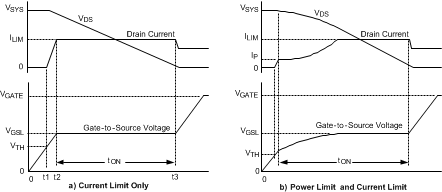ZHCSLQ5D October 2007 – August 2020 LM5067
PRODUCTION DATA
- 1 特性
- 2 应用
- 3 说明
- 4 Revision History
- 5 Device Comparison
- 6 Pin Configuration and Functions
- 7 Specifications
- 8 Detailed Description
-
9 Application and Implementation
- 9.1 Application Information
- 9.2
Typical Application
- 9.2.1 Design Requirements
- 9.2.2 Detailed Design Procedure
- 9.2.3 Application Curves
- 10Power Supply Recommendations
- 11Layout
- 12Device and Documentation Support
- 13Mechanical, Packaging, and Orderable Information
9.2.2.4.2 Turn-on With Power Limit and Current Limit
The power dissipation limit in Q1 (PFET(LIM)) is defined by the resistor at the PWR pin, and the current sense resistor RS. See Power Limit Threshold. If the current limit threshold (ILIM) is higher than the current defined by the power limit threshold at maximum VDS (PFET(LIM)/VSYS) the circuit operates initially in power limit mode when the VDS of Q1 is high, and then transitions to current limit mode as the current increases to ILIM as VDS decreases. See Figure 9-5b. Assuming the load (RL) is not connected during turn-on, the time for the output voltage to reach its final value is approximately equal to:

For example, if VSYS = –48 V, CL = 1000 µF, ILIM = 1 A, and PFET(LIM) = 20 W, tON calculates to ≊ 68 ms, and the initial current level (IP) is approximately 0.42A.
The Fault Timeout Period must be set longer than tON
 Figure 9-5 MOSFET Power Up Waveforms
Figure 9-5 MOSFET Power Up Waveforms